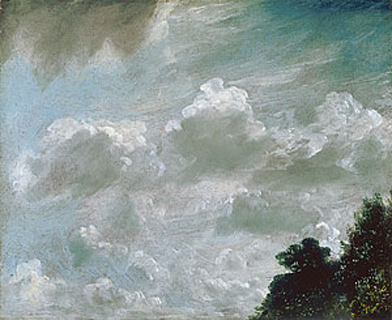On the last Sunday before the start of autumn, this week’s picture is John Constable’s fresh and exhilarating study of clouds scudding through the sky above his lodgings in Hampstead. He painted it some time shortly after 10 o’clock on the morning of 11 September 1821, scribbling a note of the weather conditions on its reverse: “Morning under the sun – Clouds silvery grey … Light wind to the SW, fine all day – but rain the following evening.” There had been rain the day before too, when he had been forced to stop work due to “large drops of rain on my palette.”
Notwithstanding such trials and interruptions the beginning of autumn was one of the painter’s favourite times of year, a season when the world was apt to seem refreshed and reinvigorated after the sleepy torpor of high summer: “silvery, windy and delicious,” in Constable’s own words, “all health, and the absence of everything stagnant.” These were qualities that he yearned to capture in his landscape paintings, but at the start of the 1820s he felt that his art was failing to fulfil his ambitions for it. The chief problem, in his view, was his handling of skies. He embarked on a prolonged campaign of study, producing numerous oil sketches of clouds and their movements. Constable explained his motives in a fascinating letter to his best friend, Archdeacon John Fisher, dated October 23, 1821:
“That landscape painter who does not make his skies a very material part of his composition, neglects to avail himself of one of his greatest aids. Sir Joshua Reynolds, speaking of the landscapes of Titian, of Salvator and of Claude, says: ‘Even their skies seem to sympathise with their subjects. I have often been advised to consider my sky as ‘a white sheet...


